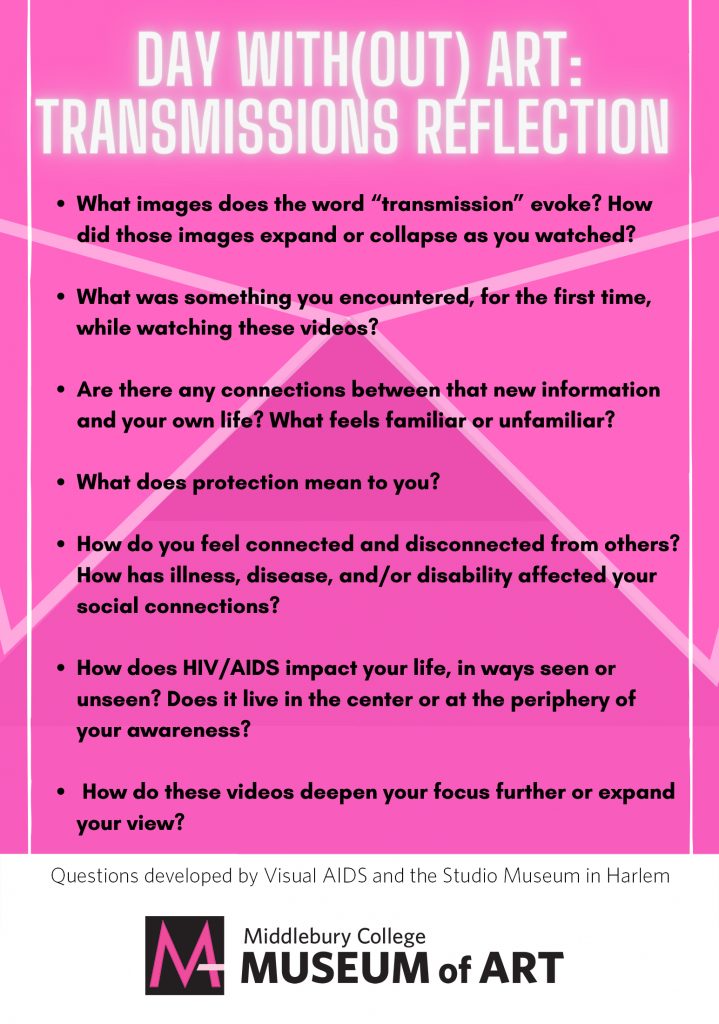On November 30 Visual AIDS premiered TRANSMISSIONS, a program of six new videos considering the impact of HIV and AIDS beyond the United States. For those who were not able to attend the premiere those videos are now available to stream, and we encourage you to visit the TRANSMISSIONS website to watch the films (please note that some videos contain mature content.)
2020 marks the second year that the Student Friends of the Art Museum (SFOAM) have partnered with GlobeMed, a student organization dedicated to improving global health, and the Rohatyn Center for Global Affairs to offer a panel discussion at Middlebury designed to frame the issue of HIV/AIDS in a global context.
Panel Details:
Saturday, December 5, at 2:00 PM EST, via Zoom (click here to join)
The speakers include: Kelly Arbor from VTCares; Dr. Julie Hoffman; Dr. Jason Leider; and a leading advocate for people living with HIV/AIDS from Jacobi Medical Center.
Resources and Learning Materials
In this posting we begin to offer resources and discussion prompts to facilitate engagement around this topic. Beginning next year, this will evolve into a full microsite dedicated to explorations and community interactions around the subject of HIV/AIDS in the world, with Visual AIDS’ annual Day With(out) Art video series at its core. We’re very much interested to hear from participants about the different features and components such a site would embody, so please share your thoughts and suggestions in the comments.
Discussion Questions
The discussion questions in the graphic below were developed by Visual AIDS and the Studio Museum in Harlem to provoke dialogue. We encourage panel participants to download this graphic and refer to it while watching the films in advance.


Know your status! Anonymous HIV testing:
- Vermont Department of Health AIDS Hotline: 1-800-882-AIDS (2437)
- Vermont Cares: 802-863-2437
Websites:
- Visual AIDS website
- Vermont Cares
- University of Vermont Medical Center’s HIV/AIDS Comprehensive Care Clinics in Vermont
- 20 Essential Films About HIV/AIDS (POZ)
- Global information on HIV/AIDS: AVERT
Middlebury College Resources:
- Sex Positive Education for College Students (SPECS) Resources page (Note: their safe sex and STI/STD resources link to external sites)
- Middlebury College Center for Health and Wellness
- Confidential (not anonymous) HIV testing: call 443-5135
- Pre-Exposure HIV Prophylaxis (PrEP) counseling and prescriptions
- Counseling
Glossary
Anti-Racism is defined as the work of actively opposing racism by advocating for changes in political, economic, and social life, in opposition to individual racist behaviors and impacts. (Source: Race Forward)
Harm Reduction refers to strategies that aim to reduce the harms associated with activities deemed by the culture to be dangerous, such sex and taking drugs. The contemporary concept of harm reduction emerged out the early 1980s at the beginning of the HIV epidemic when healthcare workers started to provide clean syringes to people who inject drugs rather than solely trying to achieve abstinence. Other examples of harm reduction include condoms, PrEP, and seat belts. (Multiple sources, including Avert.org)
HIV Criminalization refers to laws that punish perceived or potential HIV exposure and alleged nondisclosure of HIV status prior to sexual contact (including acts such as biting or spitting that cannot transmit HIV). HIV criminalization has resulted in sentences up to thirty years and sometimes requires sex offender registration, often in instances where no HIV transmission occurred or was even likely or possible. (Source: AIDS Watch)
Human Immunodeficiency Virus (HIV) is a virus that attacks the body’s immune system, reducing the number of CD4 cells (T cells), making people more vulnerable to other infections or cancers. If not treated, HIV can lead to AIDS (acquired immunodeficiency syndrome). People are diagnosed with AIDS when their CD4 cell count drops below 200 cells/mm or if they develop certain types of illnesses. (Source: Centers for Disease Control)
Intersectionality “is a lens through which you can see where power power comes from and collides, where it interlocks and intersects. It’s not simply that there’s a race problem here, a gender problem here, and a class or LGBTQ problem there. Many times that framework erases what happens to people who are subject to all of these things.” (Source: Kimberlé Crenshaw)
Narcan (Naloxone) is a life saving medication that reverses the effects of opioid overdose. It only works on opioids (heroin, prescription painkillers, fentanyl).
Needle / Syringe Exchange is a process where people exchange used needles for new needles. Needle exchange is an example of harm reduction, which focuses on reducing harm, rather than enforcing abstinence.
Pharmacide can be understood as the act of murder through prescription medication, specifically through its overuse or misuse by innocent patients. Related is the term pill fatigue which is a condition where people will chronic illness stop taking medication because of the stress and monotony of constant pill swallowing, thus resulting in an issue with adherence: the endless task of doing what you don’t want to with a regular rhythm (taking meds). (Source: Urban Dictionary)
Pre-Exposure Prophylaxis (PrEP) is a daily medicine for HIV-negative people to lower their chances of getting HIV. To learn more about PrEP, including where you can find it in your area, visit: PrEPLocator.org.
Post-Exposure Prophylaxis (PEP) is an antiretroviral medicine that greatly reduces chances of transmission if taken within 72 hours of exposure. PEP should be available in all emergency rooms.
Redlining is the systematic denial of services to residents of specific neighborhoods (often racially associated), either directly or through the selective raising of prices. While the best known examples of redlining have involved denial of financial services such as loans or insurance, other services such as health care or even supermarkets have been denied to residents. (Source: Wikipedia)
Stigma is a mark of shame or prejudice. People living with HIV experience stigma in many ways, including in their intimate relationships. When something like HIV is stigmatized, it can distort factual information and trigger certain behaviors and attitudes, such as:
- Thinking that people deserve to get HIV because of their choices
- Refusing to provide care or services to a person living with HIV
- Socially isolating a member of a community because they are HIV-positive (Source: Centers for Disease Control)
Undetectable refers to how regularly taking HIV medication can lower the amount of HIV in your blood (aka your viral load) to an undetectable level. People who are undetectable cannot transmit the virus to others. This doesn’t mean you no longer have HIV—it means that by continuing your plan of treatment, you can live with HIV by managing your health on your own terms. (Source: Housing Works)
